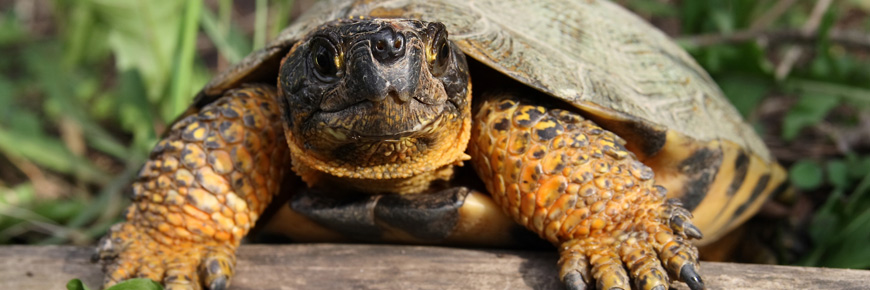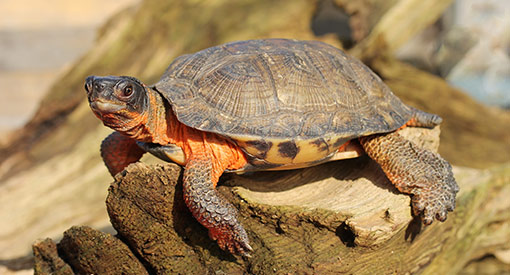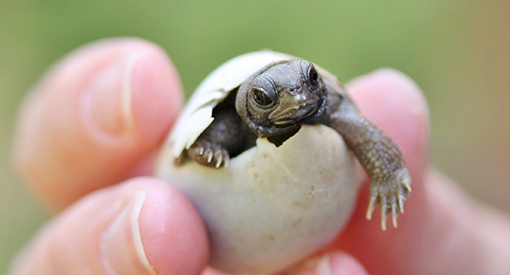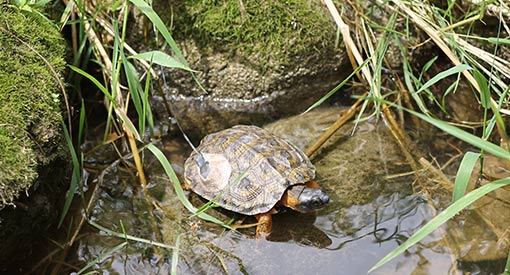
Wood Turtle
Kouchibouguac National Park
Wood turtle (Glyptemys insculpta)
In Mi’gmaq (turtle): Mikjikj
SARA Status: Threatened
Having been present since the age of the dinosaurs, some 175 million years ago, the wood turtle was once abundant in southeastern Canada and northeastern United States. For Indigenous Peoples, the turtle (or Mikjikj, in Mi’gmaq) has always been of great importance. According to Indigenous mythology, the turtle represents Mother Earth since the great island of North America was created on its back. As a symbol of wisdom, longevity and perseverance, the turtle has been greatly valued and respected among Indigenous Peoples for millennia.

Photo: Jory Mullen
The wood turtle is an omnivorous, semi-aquatic reptile that lives year-round in watersheds of healthy winding rivers and streams such as those found within and around the park’s boundaries. The species’ life cycle and reproductive success depend greatly on the interconnectivity of the different habitats it visits during its active season, such as riverbank alder thickets, deciduous and mixed forests, open woodlands, peat bogs, fields and beaver ponds.
Its carapace is greyish-brown to yellow in colour and is distinguished by its scales (scutes) that have annual growth rings consisting of pyramidal concentric ridges. The ventral part of the carapace (plastron) consists of yellow scutes with black blotches. The wood turtle’s skin is mostly brown, but its neck and the upper part of its legs are more yellow, orange or reddish in colour.
Unfortunately, this reptile’s population declined rapidly at the end of the 20th century and the wood turtle is now listed as an endangered species. The main factors that led to its decline are road deaths, an increasing number of natural predators, the use of agricultural machinery, habitat loss caused by industrial and urban development, and poaching for the domestic animal black market.
Habitat

Photo: Jory Mullen
The wood turtle lives in its watersheds of winding rivers and streams that have either a sand substrate or sandy gravel bed, and good water quality. During its active season (i.e., when it’s not hibernating), the wood turtle visits a variety of ecosystem habitats including riverbank alder thickets, deciduous and mixed forests, open woodlands, peat bogs, fields, and even beaver ponds.
Threats
Road deaths
The wood turtle’s natural habitat is becoming increasingly scarce. Highway construction is one of the factors contributing to the problem. Because females are often forced to cross highways to get to their nesting sites, they face an increased risk of road death. Since road sides are often exposed to sunlight and made of gravel or sand, females sometimes choose these precarious areas as nesting grounds, which puts them and their offspring at risk of being struck by oncoming vehicles.
Subsidized predation
In addition to damaging and fragmenting its natural habitat, urban development and urbanization also artificially increase the amount of natural wood turtle predators such as red foxes, raccoons, skunks, crows, coyotes, and domestic dogs. These animals can prey on turtle eggs, juveniles, and sometimes even adult wood turtles.
Illegal harvesting
As a slow-moving species, the wood turtle is at risk of being taken from its environment and kept in captivity as a pet. Because the wood turtle reaches sexual maturity late in life, adult harvesting has a significant impact on the decline of its population. Today, it is illegal to harvest any species of turtle native to Canada, including its eggs.
Life cycle
- Awakening period
In mid-April, the Wood Turtle wakes up from its hibernation and spends much of its time warming up along sunny riverbanks. Famished, it also spends a lot of time feeding, especially in alder thickets. - Mating Period
Although wood turtles can mate throughout their active season, it generally occurs during spring or fall. - Nesting period
From late May to early July, females can travel more than 2 km to their nesting site. Because sun exposure and heat are essential for egg incubation, nests are often dug on beaches and sandy riverbanks. Unfortunately, female wood turtles sometimes choose road sides as nesting grounds, as they are often exposed to the sun and are usually made of gravel/sand. Having nests so close to vehicle traffic puts females and their offspring in a precarious situation. - Hatching Period
From the end of August to early September (i.e. 10 to 12 weeks after the eggs are laid), eggs hatch. In the spring, females are capable of laying up to 20 eggs, but average 8 to 12. - Hibernation period
To avoid freezing, wood turtles spend the winter alone, or in groups, buried in a hibernating site known as a hibernacula. These burrows may be located in the mud, under an overhanging bank or at the bottom of a well-oxygenated stream.

Photo: Jory Mullen
In 2015 and 2016, four ecological passages were installed underneath a key section of the park’s main highway (i.e. Route 117) in an effort to help reduce the number of collisions between vehicles and wildlife. A fencing system was also installed to connect the passages and guide travelling and migrating animals towards the underground wildlife crossings. These underpasses help keep various habitats interconnected and are beneficial not only for turtles, but also for amphibians and small to medium-sized mammals. For more information, visit the Rehabilitation of Route 117 web page.
- Date modified :